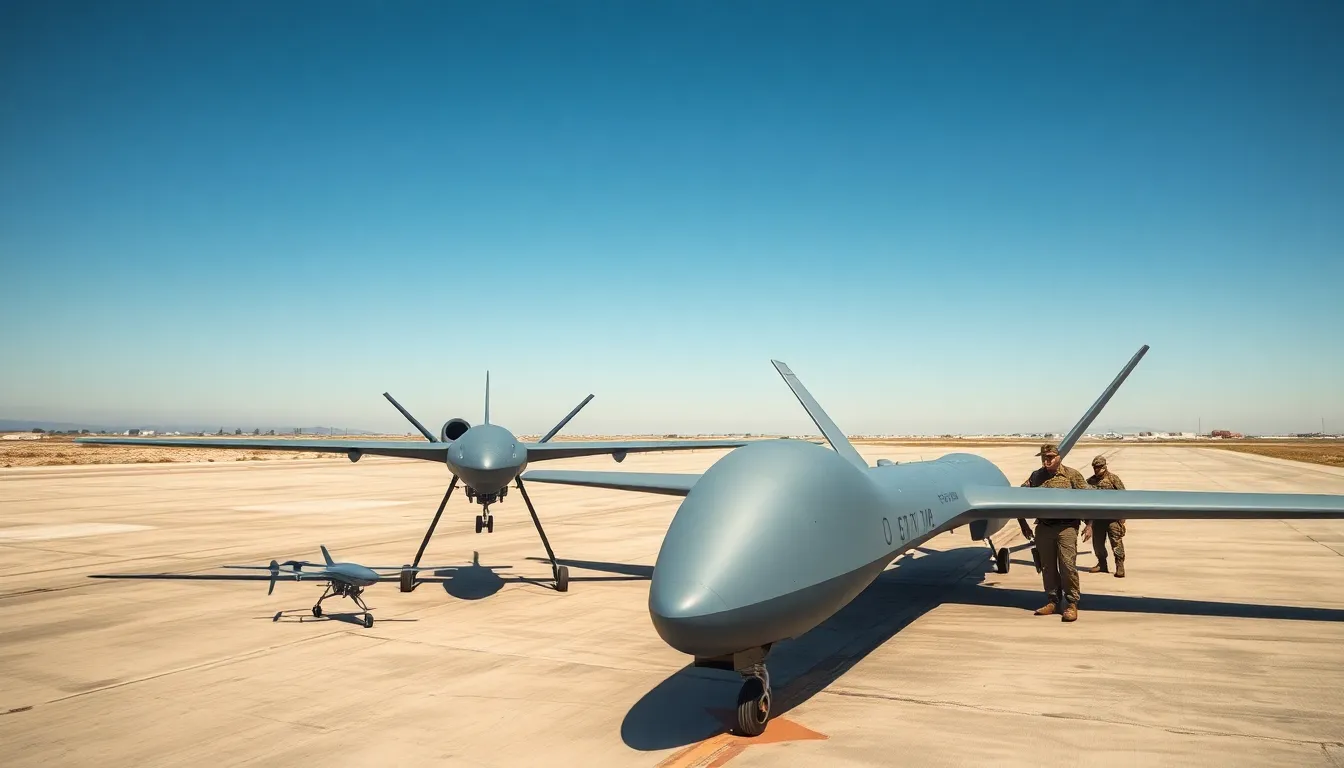When it comes to military drones, size really does matter—just ask the pilots who’ve traded in their cockpits for a cozy seat behind a screen. These high-tech marvels come in all shapes and sizes, from the compact ones that could fit in your backyard to the massive behemoths that could easily pass for a small passenger jet. But how big are they really?
Table of Contents
ToggleUnderstanding Military Drones
Military drones vary significantly in size, reflecting their diverse operational roles. Some models are compact and lightweight, designed for reconnaissance missions and capable of fitting in a backpack. Others are substantially larger, resembling small passenger jets and equipped for strike missions and surveillance.
Small drones typically measure around 2 to 5 feet in wingspan. Examples include the RQ-11 Raven and the Wasp III, used primarily for tactical reconnaissance. Their portability allows soldiers to deploy them quickly in the field.
Medium-sized drones, such as the MQ-1 Predator, can reach wingspans of about 48 feet. They provide enhanced surveillance capabilities and can carry payloads for precision strikes. These drones operate at higher altitudes, enabling longer flight times and expanded observational ranges.
Large drones like the MQ-9 Reaper have wingspans of up to 66 feet. They serve as unmanned aerial vehicles capable of executing complex missions, including intelligence gathering and missile attacks. This size allows them to carry more substantial payloads and utilize advanced sensor technologies.
The size of military drones influences their performance and effectiveness. Smaller models excel in agility and quick deployment. Larger drones benefit from extended range and capabilities, which make them essential for modern military strategy. Each size category offers unique advantages, making them crucial assets in various operational scenarios.
Categories of Military Drones

Military drones fit into several categories based on their size and operational roles. Each category addresses specific needs in modern warfare.
Tactical Drones
Tactical drones serve immediate, short-range missions. These small devices typically range from 2 to 5 feet in wingspan. Designed for reconnaissance, they provide real-time intelligence on enemy positions. The RQ-11 Raven exemplifies a tactical drone, featuring portability and ease of deployment. With flight times of 60 to 90 minutes, these drones offer flexibility for ground troops in combat zones. Their ability to navigate difficult terrains enhances situational awareness. Notably, tactical drones excel in delivering crucial data without putting pilots at risk.
Strategic Drones
Strategic drones conduct long-range missions with advanced capabilities. Their wingspans often reach between 40 and 70 feet, allowing for stable flight even at high altitudes. The MQ-9 Reaper, a prime example, can remain airborne for over 24 hours while engaging in surveillance and strike operations. Equipped with sophisticated sensors, these drones gather intelligence over vast areas. Their capacity to carry armaments adds to their versatility in combat scenarios. Strategic drones play a key role in shaping military strategies, providing profound insights and extensive operational reach.
Dimensions of Military Drones
Military drones exhibit a wide variety of dimensions, serving different operational roles. Their sizes range from compact models ideal for tactical missions to larger versions designed for strategic applications.
Length and Wingspan
Lengths of military drones vary significantly. Small drones, such as the RQ-11 Raven, feature wingspans around 2 to 5 feet, making them highly portable and suitable for short-range reconnaissance. Medium-sized options, like the MQ-1 Predator, possess wingspans of approximately 48 feet, allowing for improved surveillance capabilities. Large drones, exemplified by the MQ-9 Reaper, extend their wingspans to about 66 feet, making them indispensable for complex military operations. With these varying dimensions, military drones adapt to numerous mission profiles, leveraging size to enhance performance.
Weight and Capacity
Weights of military drones also differ considerably, influencing their operational effectiveness. Compact drones, such as the RQ-11, typically weigh under 5 pounds, enabling easy transport and rapid deployment. Medium drones weigh around 1,000 pounds and incorporate advanced sensor systems for detailed intelligence gathering. Heavy-duty drones, like the MQ-9 Reaper, can weigh over 10,000 pounds and carry substantial payloads. Payload capacities range from just a few pounds on smaller models to over 3,800 pounds on larger drones, accommodating various armaments and surveillance equipment. Each weight category plays a critical role in defining a drone’s mission capabilities and effectiveness on the battlefield.
Factors Influencing Drone Size
Size in military drones is significantly influenced by various factors related to their intended use and technological advancements. These factors include mission requirements and technology and design specifications.
Mission Requirements
Mission requirements dictate the size of military drones. Tactical missions often utilize small drones that measure 2 to 5 feet, enabling rapid deployment and maneuverability. Intelligence, Surveillance, and Reconnaissance (ISR) tasks benefit from these compact drones due to their ability to navigate challenging environments. For longer-range missions, larger drones like the MQ-9 Reaper are essential, with wingspans of approximately 66 feet and the capacity to carry heavy payloads. These larger models support complex operations, including missile strikes and extensive surveillance. Effectiveness in diverse scenarios strongly hinges on selecting the right drone size based on specific operational goals.
Technology and Design
Technology and design greatly impact the dimensions of military drones. Advanced sensor systems and improved materials contribute to drone performance while necessitating different sizes. For instance, medium-sized drones such as the MQ-1 Predator combine substantial wingspans of about 48 feet with features like enhanced durability and flight endurance. Innovations in aerodynamics also inform design choices, influencing drone capability and agility. Each technological advancement can lead to adjustments in size to enhance operational efficiency and effectiveness. The integration of new technology reshapes drone designs, optimizing them for various strategic missions.
The diverse sizes of military drones play a pivotal role in their operational effectiveness. From small tactical models to large strategic platforms each category is tailored for specific missions. This variety not only enhances military capabilities but also reflects the ongoing evolution of drone technology. As advancements continue to reshape the landscape of aerial warfare the significance of size will remain a crucial factor in determining the success of military operations. Understanding these dimensions helps to appreciate the strategic advantages that different drones bring to the battlefield.



